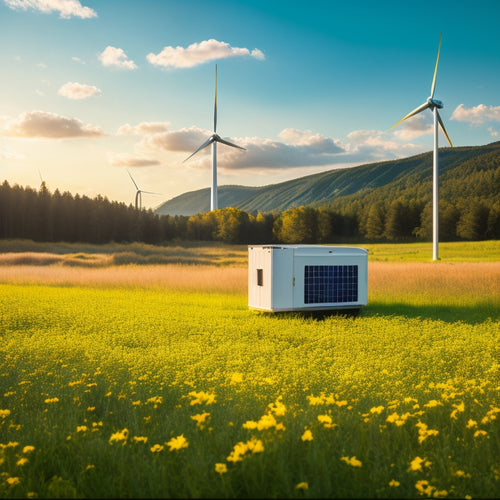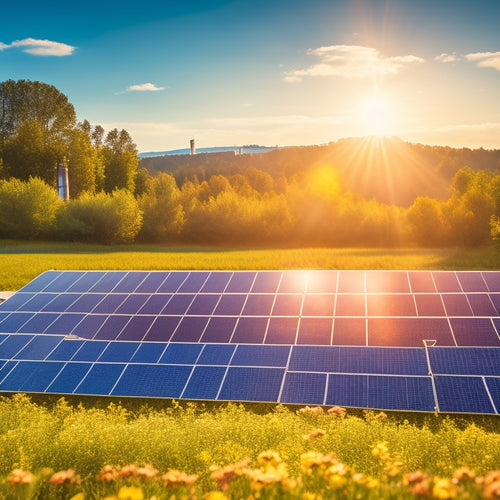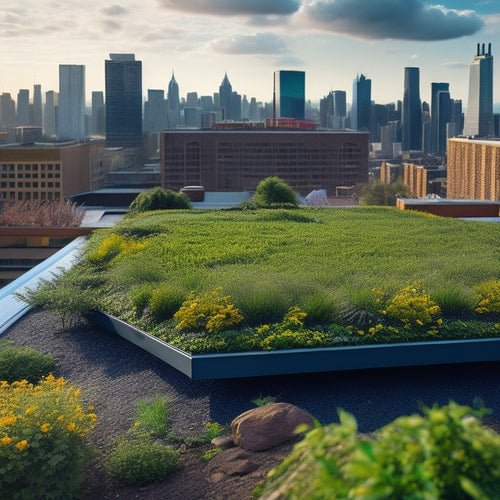
Off Grid Cooling Solutions for a Sustainable Future
Share
Off-grid cooling solutions enable you to create a sustainable environment while reducing energy costs considerably. By integrating passive techniques like natural ventilation, thermal mass, and effective shading, you can optimize your indoor climate without heavy energy use. Pair these methods with renewable energy sources, such as solar or wind, to enhance reliability and independence. Select systems customized to your climate zone for maximum efficiency, ensuring comfort in any weather. This innovative approach not only lowers your carbon footprint but also alters your living space into an energy-efficient haven. There's much more to investigate about these solutions that can boost your sustainability experience.
At a Glance
- Off-grid cooling solutions utilize renewable energy sources, reducing reliance on conventional power and lowering overall energy consumption.
- Passive cooling techniques, such as natural ventilation and thermal mass, optimize indoor comfort while minimizing energy use.
- Advanced humidity control and innovative ventilation strategies enhance indoor air quality without mechanical cooling, promoting sustainability.
- Incorporating solar and wind energy systems ensures reliable cooling while decreasing environmental footprints and energy expenses.
- Regular energy audits identify inefficiencies, enabling optimized cooling systems for improved energy efficiency and cost savings.
Energy-Efficient Temperature Control
To achieve energy-efficient temperature control, you can utilize passive cooling techniques that work with your environment rather than against it.
Implementing energy independence through off-grid solar systems can further enhance your cooling solutions by providing a reliable power source.
By integrating renewable energy sources, you not only reduce reliance on traditional power grids but also enhance your cooling systems' sustainability.
Exploring these strategies will enable you to maintain comfortable temperatures while minimizing energy consumption.
Passive Cooling Techniques
While many people depend on mechanical systems to keep their spaces cool, passive cooling techniques offer a sustainable and energy-efficient alternative. You can capitalize on natural ventilation by strategically positioning windows and vents to promote airflow management. This way, you'll tap into the cooling breezes and reduce reliance on electricity.
Incorporating thermal mass into your building design helps absorb and store heat during the day, releasing it when temperatures drop. Green roofs not only provide insulation but also reduce heat absorption, making your space cooler.
Employing effective shading strategies, like awnings or overhangs, will protect your home from direct sunlight and lower indoor temperatures. Consider earth cooling techniques, which make use of the earth's stable temperature to keep your environment comfortable.
Adding water features, like ponds or fountains, can enhance this cooling effect through evaporation. Additionally, thoughtful building orientation and site design can maximize shade and minimize heat gain.
Lastly, using advanced insulation techniques guarantees your home retains cool air, allowing for a more comfortable indoor climate without relying on energy-intensive systems. By embracing these innovative methods, you take control of your comfort sustainably, achieving true independence.
Renewable Energy Integration
Integrating renewable energy sources into your cooling systems can significantly enhance energy-efficient temperature control. By utilizing solar thermal and wind energy, you can create a sustainable, off-grid cooling solution that minimizes reliance on conventional power sources. This approach not only contributes to your energy independence but also reduces your environmental footprint.
Here's a comparison of how different renewable energy solutions can impact your cooling system:
| Energy Source | Benefits |
|---|---|
| Solar Thermal | Directly heats or cools air, reducing energy usage |
| Wind Energy | Powers electric cooling units, offering consistency and reliability |
| Hybrid Systems | Combines solar and wind for peak energy efficiency |
| Battery Storage | Stores excess energy for use during low production periods |
Cost Savings Over Time
When you switch to off-grid cooling solutions, you're not just making a temporary change; you're investing in long-term energy savings.
By integrating energy storage solutions, such as solar batteries, into your cooling system, you can further reduce your reliance on traditional power sources, leading to even greater utility expense reductions.
This shift can lead to a more sustainable and economically viable way to keep your space comfortable while also assessing energy needs for peak battery performance.
Long-Term Energy Savings
Investing in off-grid cooling solutions can lead to significant long-term energy savings that directly impact your bottom line.
By conducting energy audits, you can identify inefficiencies in your current cooling systems and optimize them for greater efficiency. Effective insulation materials and smart building orientation enhance thermal comfort while minimizing energy use.
Implementing advanced humidity control techniques guarantees that your indoor air quality remains high without over-relying on mechanical cooling.
Integrating outdoor shading can reduce heat gain, allowing your cooling systems to operate more efficiently.
Moreover, employing innovative ventilation strategies can facilitate natural airflow, further decreasing your energy demand.
Energy modeling tools can help you predict how these elements work together, enabling you to make informed decisions that improve your energy savings.
Reduced Utility Expenses
One of the most persuasive benefits of off-grid cooling solutions is the significant reduction in utility expenses over time. By implementing smart thermostats and insulation techniques, you can optimize your energy usage and minimize costs. DIY solutions become essential as you investigate community initiatives that promote sustainable practices customized to your local climate.
To illustrate the potential savings, consider the following table:
| Solution | Estimated Annual Savings |
|---|---|
| Smart Thermostats | $150 |
| DIY Insulation Improvements | $200 |
| Thermal Mass Enhancements | $100 |
| Water Conservation Methods | $75 |
| Energy Audits | $50 |
These figures reflect how strategic investments in building materials and zoning regulations can drive down your utility expenses. Each initiative not only contributes to your wallet but also aligns with a commitment to sustainability. As you adopt these practices, you're not just saving money; you're gaining the freedom to live responsibly in harmony with nature. By focusing on cost-effective strategies, you can achieve a lifestyle that's both eco-friendly and economically viable.
Unique System Capabilities
When considering off-grid cooling solutions, you'll find that innovative design features can greatly enhance your system's performance.
Solar cooling systems not only improve energy independence but also reduce reliance on traditional energy sources, allowing for a more customized cooling strategy.
These capabilities not only improve energy efficiency but also tailor your cooling strategy to your specific needs.
Innovative Design Features
Off-grid cooling solutions are revolutionizing how we approach temperature regulation in sustainable living. You'll find that innovative design features, like biophilic design, enhance not just aesthetics but functionality. By integrating natural elements into your space, you create a more comfortable environment that harmonizes with nature.
Imagine large windows that invite natural airflow while providing stunning views, reducing your reliance on mechanical cooling.
Thermal mass is another breakthrough. Using materials like concrete or stone, you can store and release heat during the day and night. This passive cooling strategy minimizes temperature fluctuations, ensuring your space remains comfortable without the need for energy-intensive systems.
Incorporating these elements into your off-grid setup enables you to take control of your comfort and reduces your environmental footprint. You're not just creating a living space; you're crafting a sanctuary that thrives on innovation and sustainability.
With these unique system capabilities, you can enjoy a cooler, more serene lifestyle while welcoming your desire for freedom from traditional energy sources. Welcome the future of cooling solutions and reshape your living environment into an example of sustainable design.
Energy Efficiency Strategies
While exploring energy efficiency strategies for off-grid cooling, you'll uncover that unique system capabilities can greatly improve your overall comfort and sustainability.
Start by conducting energy audits to identify areas for enhancement. Smart thermostats can optimize your cooling settings, guaranteeing you're only using energy when needed.
Consider insulation upgrades to minimize heat transfer, and use green materials that improve your building's thermal performance.
Pay attention to building orientation; positioning your structure to maximize natural ventilation can markedly reduce reliance on mechanical cooling.
Incorporate effective ventilation strategies that promote airflow while maintaining indoor air quality.
Implementing heat recovery systems can utilize waste energy, while thermal mass can store coolness during the day to release at night, stabilizing temperatures.
Energy storage solutions, such as batteries, allow you to capture excess solar energy for later use, assuring you're never left in the heat.
Finally, zoning systems can help you manage different areas of your space, providing customized cooling where and when you need it.
Selecting Based on Climate Zone
When selecting off-grid cooling solutions, understanding your climate zone is essential.
Each zone has unique characteristics that influence which cooling technologies will be most effective.
For instance, solar-powered cooling systems can greatly reduce energy bills in sunny regions, while geothermal systems may be more suitable for areas with stable ground temperatures.
Climate Zone Characteristics
Understanding climate zone characteristics is vital for selecting the right cooling solutions for your off-grid setup. Each climate zone presents unique challenges and opportunities.
In tropical climates, you'll face high humidity levels and intense heat, which require adaptive strategies to maintain comfort. Conversely, arid zones often experience drastic temperature fluctuations, necessitating efficient thermal mass techniques to stabilize conditions.
Temperate regions provide a balance, with seasonal changes that allow for varied cooling approaches throughout the year. Here, you can utilize natural ventilation and shading to combat urban heat and improve comfort.
In polar climates, the focus shifts to insulation and passive solar heating, as cooling needs are minimal but essential during warmer months.
Microclimates variations also play a significant role, as local conditions can differ dramatically from broader regional characteristics. Understanding these specific weather patterns helps you tailor your cooling solutions effectively.
Ultimately, successful climate adaptation hinges on your ability to analyze these factors, enabling you to create a sustainable, off-grid lifestyle that respects both your comfort and the environment. Welcome the freedom to innovate and adapt your cooling strategies based on your unique climate zone.
Appropriate Cooling Technologies
Choosing the right cooling technology for your off-grid setup hinges on the specific climate zone you've identified. In hot, dry areas, consider evaporative cooling systems that leverage low humidity to cool your space efficiently.
You might also examine thermal mass materials that absorb heat during the day, releasing it at night, which can stabilize indoor temperatures.
If you're in a more humid climate, geothermal systems could be your best bet. They employ the earth's constant temperature to effectively manage heat, while heat exchangers can help maintain comfortable indoor conditions.
Pair these systems with effective thermal insulation to guarantee minimal energy loss.
In all scenarios, implement radiant cooling techniques and smart thermostats for ideal control over your environment.
Conduct regular energy audits to assess your system's performance and identify areas for improvement.
Don't forget about microclimate management; understanding how your surrounding environment affects temperature can lead to smarter bioclimatic design choices.
Lower Environmental Impact
When you choose off-grid cooling solutions, you're not just enhancing your comfort; you're also greatly reducing energy consumption.
By utilizing natural methods and sustainable technologies, you can lower your carbon footprint while maintaining an efficient cooling environment.
This shift not only benefits your immediate surroundings but also contributes to a healthier planet.
Reduced Energy Consumption
Off-grid cooling solutions greatly reduce energy consumption, making them an environmentally-friendly choice for sustainable living. By utilizing natural ventilation, you can greatly lower the need for energy-intensive cooling systems.
When you design your space to promote airflow, you create a revitalizing breeze that cools without relying on electricity. This approach not only saves energy but also enhances your connection with the outdoors, allowing you to enjoy fresh air and a natural climate.
Incorporating thermal mass into your building design is another innovative strategy. Materials like concrete or stone can store heat during the day and release it at night, helping maintain a stable indoor temperature.
This passive cooling technique minimizes energy use by reducing reliance on artificial cooling methods.
As you investigate off-grid options, remember that every small change contributes to a larger impact. By adopting these practical approaches, you're not just cutting costs; you're embracing a lifestyle that prioritizes freedom and sustainability.
You can take control of your energy consumption and create a comfortable living space while protecting the environment. In a world where every choice matters, these strategies enable you to live harmoniously with nature.
Frequently Asked Questions
What Are the Maintenance Requirements for Off-Grid Cooling Systems?
To maintain off-grid cooling systems, you'll need regular filter replacements, system cleaning, and performance monitoring. Focus on energy efficiency, temperature regulation, and noise reduction for peak function and to enhance your independence from traditional power sources.
How Do Off-Grid Solutions Compare to Traditional Cooling Methods?
Like Prometheus stealing fire, you utilize energy efficiency with off-grid solutions. They often reduce environmental impact compared to traditional methods, offering you independence and innovative cooling while promoting sustainability in your lifestyle choices.
Can These Systems Be Integrated With Renewable Energy Sources?
You can definitely integrate solar thermal and passive cooling systems with renewable energy sources. This combination maximizes efficiency, reduces energy costs, and enables you to maintain a comfortable environment while embracing sustainability and independence from traditional energy grids.
What Are the Lifespan Expectations for Off-Grid Cooling Technologies?
When considering lifespan expectations for off-grid cooling technologies, you'll find that lifespan factors like maintenance and usage matter. With ongoing technology advancements, you can expect these systems to last longer and perform more efficiently.
Are There Any Incentives for Installing Off-Grid Cooling Systems?
Did you know that over 30% of homeowners benefit from financial incentives? By exploring government programs, you can greatly reduce installation costs for off-grid systems, enhancing your freedom and sustainability while enjoying a cooler environment.
Explore More
In embracing off-grid cooling solutions, you're not just planting seeds for a sustainable future; you're cultivating a thriving ecosystem of energy efficiency and cost savings. By choosing systems customized to your climate zone, you're utilizing nature's rhythms to minimize environmental impact. As you steer through these innovative technologies, remember that each decision you make is a step toward a cooler, greener world. So, let your commitment to sustainability bloom, and watch as the benefits unfold over time.
Related Posts
-

Sustainable and Eco-Friendly Generators for a Reduced Carbon Footprint
Sustainable and eco-friendly generators are perfect for cutting your carbon footprint and increasing energy efficienc...
-

Advantages of Solar Generating Systems Over Traditional Energy
Solar generating systems provide several key advantages over traditional energy sources. You'll experience lower long...
-

Designing a Green Roof for Maximum Energy Efficiency
Designing a green roof for maximum energy efficiency involves several key strategies. Start by selecting native, drou...


